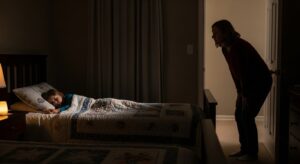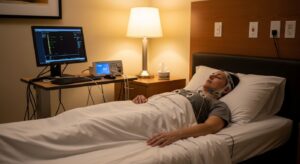Sleep is vital for everyone, especially children. It plays a crucial role in their growth, development, and overall well-being. However, many children experience sleep issues. These can range from mild disturbances to serious disorders.
One common sleep disorder in children is sleep apnea. It’s characterized by pauses in breathing during sleep. This can lead to daytime sleepiness, behavioral issues, and other health problems. Understanding these sleep issues is the first step towards addressing them. It’s important for parents, caregivers, and educators to recognize the signs and know when to seek help.
A children’s sleep study can be a valuable tool in diagnosing sleep disorders. It provides detailed information about a child’s sleep patterns, breathing, and more. Treatment for sleep disorders in children can involve behavioral changes, medical interventions, or a combination of both. The goal is to improve the child’s sleep quality and overall health.
This article aims to provide a comprehensive understanding of sleep disorders in children. It will cover their impact, how to recognize them, and the available treatments. By being informed, you can help improve the sleep health of your child and ensure their optimal growth and development.
The AAP offers guidelines and resources on sleep health for children, including recommendations for sleep duration by age and tips for establishing healthy sleep habits. Visit AAP.
The Importance of Sleep for Child Development

Sleep significantly affects a child’s growth. During sleep, the body produces growth hormones, crucial for physical development. These hormones also help repair tissues and muscles.
Furthermore, sleep influences cognitive development. Adequate sleep enhances memory, attention, and learning capabilities. Without sufficient rest, a child’s academic performance might suffer.
Emotional well-being is linked to sleep quality as well. A well-rested child tends to be more emotionally stable and less prone to mood swings. Good sleep habits foster resilience and coping abilities, promoting a healthier lifestyle overall.
Recognizing Sleep Issues in Children
Identifying sleep issues in children can be challenging. Many signs may overlap with typical childhood behaviors. However, prolonged disturbances warrant closer inspection.
Disturbances in a child’s sleep can impact daily activities. Poor sleep often translates to irritability and trouble focusing in school. These changes can affect both social and academic performance.
Parents should watch for abnormal sleep patterns. Frequent night wakings or difficulty falling asleep may indicate problems. Such patterns might disrupt the entire family’s sleep.
If sleep issues persist, consider evaluating sleep environments and routines. Simple changes might uncover underlying problems. Factors like noise or irregular bedtime routines could be culprits.
Common sleep disturbances often include specific behaviors. Parents might notice snoring, restlessness, or bedwetting. Documenting these occurrences can be helpful.
The NSF provides an overview of common sleep disorders affecting children, including symptoms, causes, and treatment options. This resource can help parents identify potential issues with their child’s sleep. Learn more at NSF.
Common Signs and Symptoms
Sleep issues manifest in various forms. Children might have trouble staying asleep. Night wakings can frequently disturb peaceful rest.
Daytime sleepiness is another red flag. If a child regularly needs naps, it might indicate poor nighttime sleep. This fatigue often affects concentration and mood.
Other signs include difficulties at school or irritability. Sometimes, sleep problems mirror symptoms of ADHD. Recognizing these signs early can prompt timely intervention.
When to Seek Help
Determining when to seek help can be perplexing. Persistent problems deserve professional assessment. If sleep issues persist beyond a few weeks, consider contacting a pediatrician.
Severe symptoms, like gasping during sleep, need immediate attention. These might suggest sleep apnea, a more serious condition. Early intervention can prevent long-term complications.
An evaluation might include a referral to a sleep specialist. Sleep studies can provide insights into sleep behaviors and disorders. Professional guidance ensures tailored and effective solutions.
Types of Sleep Disorders in Children
Sleep disorders in children vary widely. Understanding them is crucial for addressing specific needs effectively. They range from sleep apnea to behavioral problems and more.
Children may struggle with different aspects of sleep. Some experience difficulties with sleep initiation, while others face frequent nighttime awakenings. Each disorder presents distinct challenges.
Common sleep disorders in children include:
- Sleep apnea
- Insomnia
- Restless Leg Syndrome
- Parasomnias (e.g., nightmares, night terrors)
- Delayed Sleep Phase Syndrome
Sleep apnea involves pauses in breathing during sleep. It is often due to blocked upper airways.
Insomnia generally manifests as difficulty falling or staying asleep.
Restless Leg Syndrome causes uncomfortable leg sensations, disrupting sleep.
Parasomnias, like nightmares and night terrors, can disturb restful sleep.
Recognizing the specific disorder helps determine the best approach. Early intervention is vital. Addressing issues promptly can prevent further complications.
Treatments vary depending on the disorder. Behavioral interventions might work for some, while others require medical treatment. A personalized approach ensures better outcomes.
This article from Healthline discusses various sleep disorders that affect children, their symptoms, prevalence, and potential treatments. It serves as a helpful guide for parents concerned about their child’s sleep patterns. Check out Healthline.
Sleep Apnea in Children
Sleep apnea in children interrupts their breathing during sleep. This disorder often goes unnoticed. It results in incomplete rest and daytime fatigue.
Children with sleep apnea may snore loudly. They might also experience pauses in breathing or gasping for air while asleep. These symptoms require prompt attention.
Enlarged tonsils and adenoids are common culprits. Obesity can also contribute to sleep apnea. Identifying the cause is crucial for effective treatment.
Treatment for sleep apnea varies. It might involve tonsillectomy or adenoidectomy. In some cases, CPAP therapy is suggested. Addressing this condition can dramatically improve a child’s quality of life.
Behavioral Sleep Problems
Behavioral sleep problems are prevalent among children. Issues often stem from poor sleep habits. These problems can usually be addressed with simple adjustments.
Common causes include irregular sleep schedules or lack of bedtime routines. Exposure to screens before bed can also exacerbate issues. Establishing consistent routines can be beneficial.
Behavioral interventions are typically effective. Setting a regular bedtime and creating a calming pre-sleep atmosphere helps. By focusing on good sleep hygiene, many issues can be resolved.
Parasomnias: Nightmares and Night Terrors
Parasomnias, like nightmares and night terrors, disrupt sleep. These occurrences are common in young children. They can cause significant stress for both the child and parent.
Nightmares are vivid dreams that can wake a child. They often cause fear, but the child usually remembers them. Assuring the child and addressing fears can help reduce their occurrence.
Night terrors, however, are different. Children may scream or thrash about but are typically unaware. They often do not remember the episode upon waking.
Parasomnias usually decrease with age. Monitoring the frequency and intensity is important. If issues persist or worsen, consulting a specialist is advisable.
Diagnosing Sleep Disorders: The Role of Children’s Sleep Study
Diagnosing sleep disorders in children often requires a comprehensive approach. A children’s sleep study is a pivotal diagnostic tool. It helps pinpoint specific sleep issues affecting the child.
A sleep study, or polysomnography, involves overnight monitoring. It assesses sleep stages and records physiological data. Key aspects include breathing patterns and brain activity.
Several parameters are measured during the study:
- Brain wave activity
- Eye movements
- Heart rate
- Blood oxygen levels
- Breathing patterns
- Leg movements
These data points help identify disorders like sleep apnea and insomnia. They provide insights into why a child may struggle with sleep. The results guide treatment options and interventions.
Children’s sleep studies are conducted in specialized sleep centers. They offer an environment similar to a child’s bedroom. This setup ensures comfort and promotes natural sleep behavior during the study.
Preparing for a Sleep Study
Preparing for a sleep study requires a few simple steps. Parents should ensure their child maintains regular sleep routines leading up to the study. This helps establish typical sleep patterns.
On the day of the study, limit naps. Encourage your child to be active during the day. This can help them feel naturally tired come bedtime.
Pack familiar items, such as a favorite blanket or toy. These items can help soothe your child in the new environment of a sleep study center. This comfort can lead to more accurate results, reflecting their natural sleep patterns.
Dress your child in comfortable sleepwear. Avoid caffeinated drinks or heavy meals before the study. Communicating openly with your child about the process can also ease any anxiety. It’s crucial for them to feel prepared and relaxed.
Treatment Options for Children’s Sleep Apnea and Other Sleep Disorders
Treatment for sleep disorders in children varies based on the condition. When dealing with sleep apnea, treatments often target airway obstruction. This can include both non-invasive and surgical methods.
For general sleep issues, lifestyle changes are often the first step. These adjustments can significantly improve sleep quality. Practicing good sleep hygiene is key to better sleep.
Here are common treatment options available:
- Continuous Positive Airway Pressure (CPAP)
- Behavioral therapy
- Dietary changes
- Tonsillectomy and adenoidectomy
- Sleep hygiene practices
- Cognitive-behavioral therapy (CBT)
- Prescription medications if necessary
CPAP is a popular treatment for children’s sleep apnea. It involves wearing a mask that provides a steady stream of air. This keeps the airway open during sleep, reducing apnea events.
Surgical options, like tonsillectomy, may be necessary. These are considered when enlarged tonsils contribute to blocked airways. Surgery can provide a permanent solution to the problem.
Each child is unique, requiring a personalized approach to treatment. Consult with healthcare providers to explore the best options. Continuous monitoring and adaptation of strategies may be required.
The CDC offers insights into the importance of sleep for children’s health and development, along with information on common sleep disorders and tips for improving sleep hygiene. Visit CDC.
Behavioral and Lifestyle Interventions
Behavioral interventions aim to modify actions that disrupt sleep. Creating a consistent bedtime routine is one effective method. This routine signals the body that it’s time to wind down.
Screen time should be limited before bed. Electronic devices can interfere with sleep cycles. Turning off screens at least an hour before bedtime is recommended.
Maintaining a comfortable and calm sleep environment is crucial. This can involve setting the right room temperature and eliminating noise. Such changes enhance the likelihood of a restful night.
Lifestyle changes can extend to diet and activity levels. Reducing caffeine and sugar intake can improve sleep. Regular physical activity also supports better sleep quality by expending energy.
Medical and Surgical Treatments
Medical interventions for sleep disorders can include medication. However, these are generally a last resort due to potential side effects. They may be appropriate for short-term use in certain conditions.
When sleep apnea is involved, CPAP therapy is a primary treatment. It helps improve breathing patterns during sleep. Regular use can effectively reduce symptoms and improve sleep quality.
Surgery may be required when other treatments don’t work. A common surgical procedure is the removal of enlarged tonsils or adenoids. This can alleviate physical obstructions in the airway.
Each medical treatment comes with its considerations and potential risks. It’s important to weigh these with a healthcare provider. Ongoing assessment helps ensure the chosen treatment remains effective.
Creating an Optimal Sleep Environment

A child’s sleep environment plays a crucial role in fostering restful sleep. Small changes can make a big difference. By optimizing their surroundings, children are more likely to experience consistent, high-quality sleep.
An ideal sleep setting is both comfortable and free from distractions. Temperature, lighting, and noise levels should be conducive to sleep. Creating the right conditions minimizes disturbances and promotes relaxation.
Here are key elements for an optimal sleep environment:
- Maintain a cool room temperature
- Use blackout curtains to block light
- Ensure a quiet setting or use white noise machines
- Choose comfy bedding and sleepwear
- Keep electronic devices out of the bedroom
Eliminating electronic devices from a child’s room is particularly important. Screens can disrupt the natural sleep cycle by interfering with melatonin production. A technology-free zone supports better sleep health.
Consistency is key when it comes to adjusting a child’s sleep environment. Regularly assess and refine these elements to maximize their effectiveness. By setting the stage for good sleep, children can enjoy the rest they need for overall well-being.
The Role of Diet and Exercise in Children’s Sleep
Diet and exercise significantly impact a child’s sleep quality. What a child eats and how much they move can either help or hinder sleep. Paying close attention to these factors can improve sleep patterns.
Foods with high sugar and caffeine can disrupt sleep, especially if consumed close to bedtime. Parents should be mindful of their child’s diet. Offering nutritious meals and snacks during the day can lead to calmer nights.
Physical activity helps promote better sleep. Children who engage in regular exercise tend to fall asleep faster and enjoy deeper sleep. A balanced routine that includes playing, sports, or simply being active supports their sleep health.
Incorporating balanced meals and regular exercise into a child’s routine sets a foundation for healthy sleep. Parents can help by setting good examples and encouraging active, healthy habits. Thus, aligning diet and exercise with sleep goals contributes to a more restful night and a healthier child.
Managing Stress and Anxiety for Better Sleep
Stress and anxiety can greatly affect a child’s sleep. Children feeling anxious or stressed often struggle to relax at night. This tension can lead to trouble falling asleep or staying asleep.
Helping children manage stress is key to improving their sleep. Parents can teach relaxation techniques like deep breathing or visualization. Encouraging children to talk about their worries also helps them feel supported and less tense.
Creating a calming bedtime routine can further ease anxiety. A consistent pre-sleep ritual, like reading a book or taking a warm bath, signals to the body that it’s time to wind down. Such practices help set the stage for restful sleep.
Conclusion: The Path to Better Sleep for Children
Improving sleep for children involves understanding and addressing any underlying issues. Parents play a crucial role in identifying sleep disorders early on.
By fostering healthy sleep habits and seeking professional support when necessary, families can enhance their children’s well-being. Ensuring kids get the rest they need helps them thrive both physically and emotionally.





